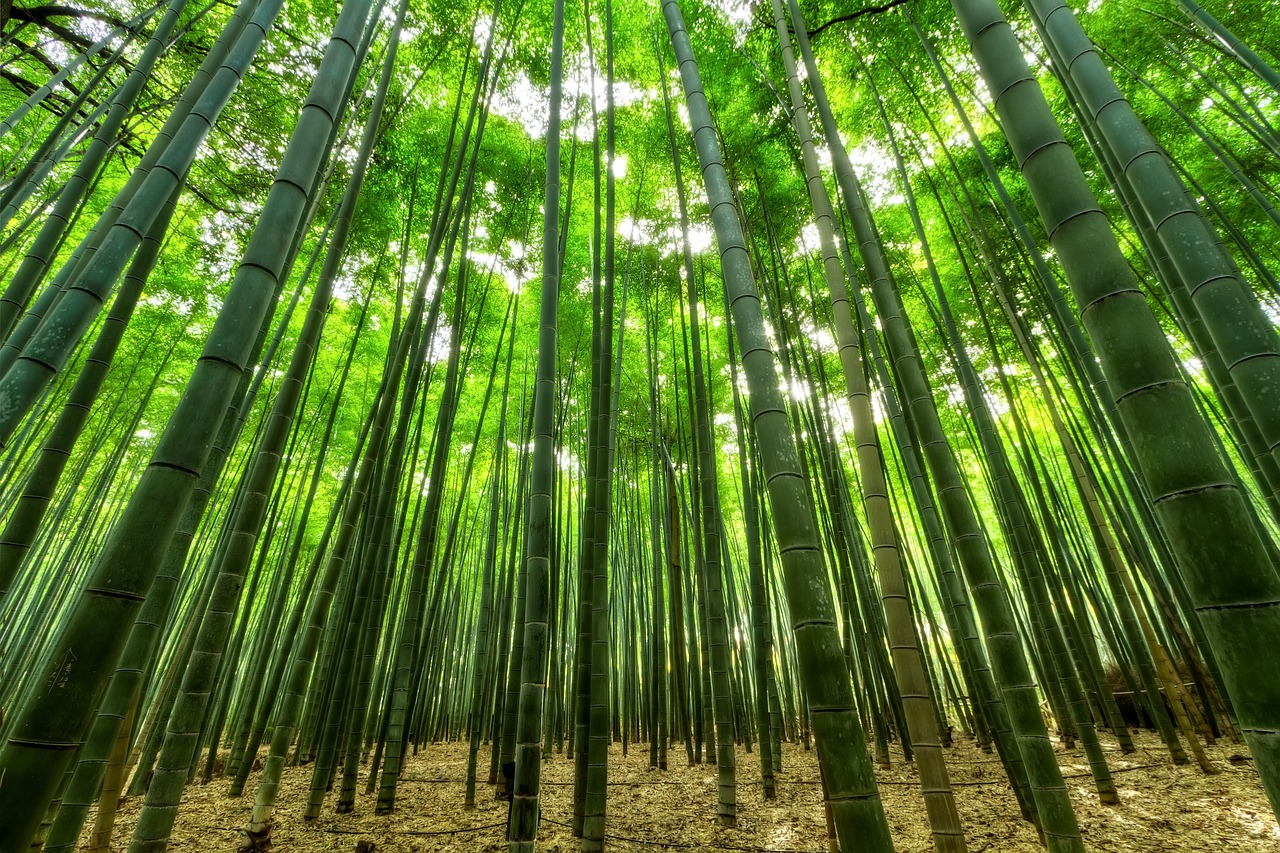Bamboo
Overview
Bamboo, a subfamily of over 1,200 species of towering grasses, thrives across various climates and favors slightly acidic, loamy soil1. Renowned for its ornamental beauty and practicality as a natural screen, bamboo is an evergreen that’s easily grown with some species-specific care and containment planning to control its vigorous growth2 3 5.

Characteristics
Known for its rapid growth, versatility in uses, and adaptation to a wide range of climates.
Region
Bamboo is commonly found or grown in diverse regions, from tropical climates to cold mountainous areas.
Natural Habitat
Bamboo is commonly found in a variety of environments, including forests, mountainsides, and grasslands.
Cultivation
Prefers slightly acidic, loamy soil (pH around 6), thrives in full sun to partial shade, and requires well-drained soil with regular watering.
Uses and Benefits
Bamboo is more than just a pretty face in the garden – it’s a multipurpose powerhouse that can elevate your outdoor space to new heights. With its lush, green foliage and elegant canes, bamboo can transform any backyard into a serene sanctuary2. Whether you’re looking to create a natural windbreak, add some privacy, or just enjoy its graceful beauty, this hardy plant is up to the task.
One of the best things about bamboo is its versatility. With over 1,200 species to choose from, there’s a bamboo variety perfect for practically any garden setting or landscaping need. Imagine creating a lush, green screen that not only looks stunning but also helps reduce noise pollution and provides a peaceful, secluded spot to unwind5.
Bamboo is also incredibly easy to grow and maintain, making it a great choice for gardeners of all skill levels. With the right conditions and a little TLC, bamboo can thrive season after season, providing you with a sustainable source of green tranquility for years to come1 4. Here are some key benefits of adding bamboo to your garden:
- Low maintenance: Once established, bamboo requires minimal care
- Fast-growing: Some species can grow up to 3 feet per day
- Eco-friendly: Bamboo absorbs CO2 and releases 35% more oxygen than trees
- Erosion control: Its extensive root system helps stabilize soil and prevent erosion
So why not add a touch of serenity to your outdoor space with the natural beauty and practicality of bamboo? Trust us, your garden will thank you!

Cultivation Tips
Growing bamboo can be a rewarding venture with the right conditions. Aim for slightly acidic, loamy soil with a pH close to 6 to make your bamboo happy1. It enjoys both the warm embrace of full sun and the cool caress of partial shade, adapting to your garden’s unique lighting situation. Keep the soil well-drained to prevent root rot, as bamboo does not thrive in soggy conditions.
For robust growth, treat your bamboo to a nitrogen-rich fertilizer, particularly if it’s grown in pots. A balanced, general-purpose fertilizer applied during the growing months will provide the necessary nutrients1 2. However, it’s essential to remember that bamboo species have individual preferences, so be sure to research your specific variety to cater to its unique needs.
When planting bamboo, consider its potential for rapid spread. Some varieties can expand quickly, invading surrounding areas if left unchecked. To maintain control over your bamboo’s growth:
- Install root barriers to prevent unwanted spreading
- Regularly prune and thin out the clumps
- Monitor for any new shoots appearing beyond the designated area
By managing your bamboo’s growth early on, you can enjoy its beauty without worrying about it taking over your garden or your neighbor’s yard.
Seasonal Considerations
When it comes to seasonal considerations, bamboo is a plant that thrives in the warmer months. During spring and summer, bamboo kicks into high gear, focusing its energy on growth and leaf production. This is the ideal time to fertilize your bamboo to support its rapid development.
As temperatures cool in autumn, bamboo growth slows down considerably. This is a great time to prune and shape your bamboo, as it will be less likely to immediately grow back. However, be careful not to overdo it, as excessive pruning can stress the plant.
Winter is a time of dormancy for bamboo. In colder climates, it’s essential to protect your bamboo from harsh winds and freezing temperatures, especially if you’re growing a less hardy variety. Mulching can help insulate the roots and prevent damage.
Regardless of the season, consistent watering is crucial for bamboo health. Aim to keep the soil evenly moist but not waterlogged. During hot, dry spells in summer, you may need to water more frequently, while in winter, you can reduce watering as the plant’s growth slows.
By tailoring your care to the changing seasons, you’ll help your bamboo thrive year-round. Remember:
- Spring/Summer: Fertilize to support growth
- Autumn: Prune and shape as needed
- Winter: Protect from cold and reduce watering
- Always: Keep soil consistently moist but not soggy
With a little seasonal know-how, you’ll be on your way to cultivating a lush, vibrant bamboo plant that will beautify your space for years to come.

Issues and Troubleshooting
While bamboo’s lush canopies and tall canes can transform any space into a tranquil oasis, it’s important to keep an eye on its vigorous growth habits. Some bamboo species can become quite invasive, spreading beyond your intended planting area if not properly controlled. To avoid a bamboo takeover, consider implementing barriers or containment methods before planting.
Establish control using these strategies:
- Install root barriers made of metal, concrete, or high-density plastic at least 2 feet deep around the planting area3
- Regularly prune and thin out bamboo stands to maintain their shape and prevent overgrowth5
- Monitor surrounding areas for any new shoots that may have escaped containment
If your bamboo appears to be struggling, ensure it has the right growing conditions. Bamboo prefers slightly acidic soil with a pH between 6.0 and 6.51. Maintain consistent moisture in the soil through regular watering, but avoid oversaturating as bamboo requires good drainage to thrive5.
Yellow leaves or stunted growth can indicate issues with sunlight or nutrition:
- Most bamboo species prefer partial shade to full sun exposure; too much direct sunlight can scorch leaves
- Ensure your bamboo receives a balanced fertilizer with equal parts nitrogen, phosphorus, and potassium every 4-6 weeks during the growing season5
- Apply a layer of organic mulch around the base of the plant to retain moisture and regulate soil temperature
By providing the right growing conditions and keeping your bamboo’s growth in check, you’ll cultivate a serene and thriving garden feature that lasts for years to come.
History and Folklore
For centuries, bamboo has been a powerful symbol of strength, resilience, and flexibility, deeply entrenched in the folklore and history of numerous cultures worldwide. Its rapid growth and ability to bend without breaking have made it an emblem of fortitude, while its associations with prosperity and purity have elevated its status beyond that of a mere plant.
In many stories and myths, bamboo is depicted as a bridge between the earthly and the divine realms. Its unique structure, being both upright and hollow, is seen as a spiritual pathway, connecting the physical world with the heavens3. This symbolism has given bamboo a revered place in the beliefs and traditions of various peoples.
Asian cultures, in particular, have long celebrated bamboo as a symbol of integrity and elegance. Its slender, graceful form and ability to sway in the wind without snapping have made it a metaphor for the ideal human character – strong yet flexible, steadfast yet adaptable. In the Western world, bamboo’s introduction was met with wonder and fascination, as people marveled at its exotic beauty and incredible versatility5.
Though the specific details of bamboo’s folklore may vary from one culture to another, its historic reverence is undeniably rich and widespread. Bamboo has transcended its status as a simple plant to become a powerful cultural icon, inspiring art, literature, and spiritual beliefs across the globe. Its enduring presence in the stories and traditions of countless generations is a testament to its timeless appeal and the deep-rooted respect it commands.
References
1. “What Are the Best Conditions for Growing Bamboo? – The Spruce”, https://www.thespruce.com/best-growing-conditions-for-bamboo-2132865
2. “Bamboo care and growing guide: expert tips – Homes & Gardens”, https://www.homesandgardens.com/gardens/bamboo-care-and-growing-guide
3. “Bamboo Plant Basics You Should Know Before You Plant”, Better Homes & Gardens, https://www.bhg.com/gardening/trees-shrubs-vines/shrubs/bamboo-gardening/
4. “How to Grow and Care for Bamboo Plants | Gardener’s Path”, Gardener’s Path, https://gardenerspath.com/plants/grasses-rushes-sedges/grow-bamboo/
5. “How to Successfully Grow Bamboo: A Field Guide for Planting, Care, and …”, Gardenista, https://www.gardenista.com/garden-design-101/grasses/bamboo-bambusoideae/
Nicolas Duval
Nicolas is a passionate advocate for nature and the art of wildcrafting. His dedication shines through in Wildcraftia, a website he meticulously crafted to serve as a haven for nature enthusiasts worldwide. Driven by a deep appreciation for nature’s connection to humanity, Nicolas embarked on his journey in 2011 with SmokableHerbs, a platform showcasing his love for nature’s bounty. Building upon this foundation, he established Smokably, a thriving online store offering premium herbs and blends to a global audience.
